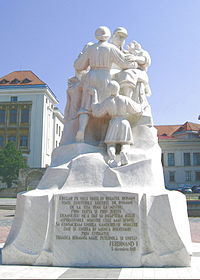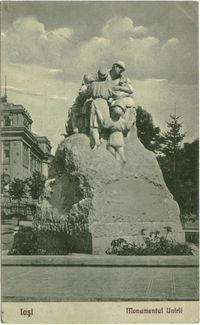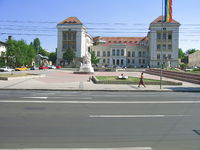- Union Monument, Iaşi
-
Union Monument (Romanian: Monumentul Unirii), a monument of white marble in the Romanian city of Iaşi, was designed by Princess Olga Sturdza and unveiled in 1927 at the base of Carol Boulevard. It consists of a central piece (the Motherland) and four smaller ones representing the historic provinces of Transylvania, Bessarabia and Bukovina (incorporated into Romania at the end of World War I) and the Romanian diaspora. Demolished in 1947 as the Romanian Communist Party was tightening its grip on the country, it was rebuilt in 1999, this time being placed in Piaţa Naţiunii, in front of the Grigore T. Popa University of Medicine and Pharmacy.
Contents
History
On August 1, 1924, Princess Olga Sturdza sent a letter to the Iaşi mayor's office, expressing her intention to donate to the city a marble monument symbolizing the Great Union of 1918:
“ Heeding the especially dear call to action of Romanians' thoughts that wishes to see erected in Iaşi a monument commemorating the Great Union, which was realised here, I have the honour of informing you that for almost five years I have been working on an allegorical group, depicting the provinces joined together in the Motherland's bosom. The monument is almost finished and brings together in a marble group, almost five metres high, five figures representing: the Motherland, Transylvania, Bessarabia, Bukovina and Romanians from everywhere who have remained outside our borders. This monument, costing almost 2 millions [lei] and which is almost finished, I grant to Iaşi. I will personally supervise and take care of the installation of the monument.[1] ” The monument was to be placed at the entrance to the palace of the great logofăt Dumitrache Cantacuzino-Paşcanu, at the end of Carol I (later Copou) Boulevard, where Queen Marie lived when the Romanian government moved to Iaşi (1916-1918), but as it was too bulky, it was agreed to place it elsewhere. Installation work began in 1925, at the Foundation intersection (at the base of Carol Boulevard). The components of the work were executed in the Copou neighbourhood, some parts being kept in Copou Garden until they were assembled.
The pedestal was of stone brought from Corbăul Clujului quarry and had four sides, its execution being entrusted to the Bucharest entrepreneur Leonardo Martinez. The following words were inscribed into the left side: "The greatest desire, the most general, that which has nourished all past generations, that which is the soul of the present generation, that which, fulfilled, will gladden future generations is union! Ad-hoc divan of Moldavia, 7 October 1858".
On the right side were words spoken by Alexander John Cuza on January 29, 1859: "The union of the crowns of Stephen the Great and Michael the Brave is the triumph of a great principle, which lives with vigour in the hearts of Romanians: the principle of Romanian brotherhood. It has saved us from perdition in the past, it revives us at the present time, it shall lead us to good things and greatness in the future. Long live Romanian brotherhood! Long live the Romanian Principalities!"
On the front side were inscribed the words of King Ferdinand, spoken on December 5, 1918: "I declare that all lands inhabited by Romanians, from the Tisa to the Nistru, to be united for the ages in the Kingdom of Romania. Through fights and sacrifices, God has granted us to realise today our most holy aspirations. Let us consecrate the union of thoughts, of souls, but also the union in fruitful labour by shouting: Long live Greater Romania, strong and united!"
Finally, on the back side were carved Olga Sturdza's words: "To the united people of Romania and to Iaşi – the cradle of unions – I offer this work of my heart and my hands. Olga I. Sturza. 29 May 1927".
The central piece "represents the Motherland, an image for which Queen Marie accepted that her face be reproduced". Each province is shown as a daughter being embraced by their mother. Aside the daughters, near the bottom of a statue there is a kneeling child who wishes to return to Mother Romania. He represents all Romanians left outside the borders decided in 1919.
For the four children, the sculptress had found representative faces among the schoolgirls of the Mihail Sturdza Normal School of Iaşi. However, newspapers of the day claimed that the feminine figures in fact depicted the queen's daughters, the princesses Elisabeth, Marioara and Ileana, and that the little boy was based on Prince Mircea, who had died at the age of three in 1916, at the beginning of the war, and remained buried in Bucharest.[2]
The Union Monument was unveiled on Sunday, May 29, 1927, at 10:15 am, before Queen Marie, Princess Ileana (King Ferdinand's daughter), Princess Helen (wife of prince Carol) and the young crown prince Michael. Ferdinand, who would die that July 20, was gravely ill and thus did not attend. After this monument was unveiled, the royal delegation took part in the unveiling of the Attacking Cavalryman Statue at 11:30.
Some reactions were negative at the time. For instance, one journalist wrote: "...a culinary work of whipped cream. One can tell a woman's hand in this. A group of five backsides is depicted."[3]
In 1947, the year the Paris Peace Treaties confirmed Romania's loss of Bessarabia and northern Bukovina to the Soviet Union, the Armistice Committee ordered the monument's demolition.
Reconstruction
On February 8, 1994, in the great hall of Iaşi city hall, a committee met and decided to rebuild the monument, among the initiators of the project being mayor Constantin Simirad. The project was financed by Olga Sturdza's direct descendant Prince Dimitrie Sturdza, a Swiss businessman, who together with his family helped finance the new group of statues.
Between 1995 and 1999, the sculptor Constantin Crengăniş paid by the Iaşi mayoralty, reconstructed the monument based on photographs. The pedestal was made from the same piece of marble as the statues, unlike the original, which had a stone base.
The monument was placed on a circular base made of slabs of white and gray marble. It was placed in Piaţa Naţiunii, in front of the Grigore T. Popa University of Medicine and Pharmacy in Iaşi, because in 1957 a statue of Mihai Eminescu was installed in the previous location. On 1 December 1999, the monument was blessed in the presence of Daniel Ciobotea, Metropolitan of Moldavia and Bukovina; Simirad and Dimitrie Sturdza were also in attendance.
On the back side, beneath the words of Olga Sturdza carved into the pedestal, the following words were inscribed: "We have rebuilt this monument as a sign of homage and recognition toward those who fought, are fighting and will fight for the joining together and the unity of the Romanian people. Mayoralty of the Municipality of Iaşi. Redone by Constantin Crengăniş, 1995-1999."
Gallery
Notes
- ^ Ostap.
- ^ Mitican.
- ^ (Romanian) Constantin Coroiu, "Ce nu scrii şi tu frumos româneşte, măi Trăsne?" (“Why Don’t You Write Romanian Nicely, Trăsne?”). Evenimentul, March 18, 2002.
References
- Mitican, Ion. Urcînd Copoul cu gîndul la Podul Verde. Ed. Tehnopress, Iaşi, 2006.
External links
- (Romanian) Constantin Ostap, “Minunea albă revine în Iaşi” (“The White Marvel Returns to Iaşi”), "Magazin Istoric", nr. 3/2000.
Historical Balș House · Braunstein Palace · Calimachi Palace · Cantacuzino-Paşcanu Palace · Cuza Palace · Grand Hotel Traian · Grigore Sturdza Palace · Metropolitan Palace · Mihai Sturza Palace · Neuschotz Palace · Palace of Culture · Roset-Roznovanu PalaceCultural Art Museum · Dosoftei House · Ethnographic Museum of Moldavia · George Topîrceanu Memorial House · Iaşi National Theatre · Ion Creangă Bojdeuca · Luceafărul Theatre · Mihai Codreanu Memorial House · Mihai Eminescu Museum · Mihail Sadoveanu Memorial House · Moldavia's History Museum · Moldova Philharmonic Orchestra · Natural History Museum · Nicolae Gane Memorial House · Otilia Cazimir Memorial House · Petru Poni Memorial House · Pogor House · Radu Cernătescu Memorial House · Romanian National Opera · Science and Technology Museum · Tătăraşi Athenaeum · Theatre Museum · Union MuseumMonasteries,
churches
and synagoguesArmenian Church · Aroneanu Monastery · Barnovschi Church · Bărboi Church · Bârnova Monastery · Bucium Monastery · Cetăţuia Monastery · Frumoasa Monastery · Galata Monastery · Golia Monastery · Great Synagogue · Hlincea Monastery · Metropolitan Cathedral · Old Catholic Cathedral · Old Metropolitan Cathedral · Royal Saint Nicholas Church · Saint Sava Church · Saint Spiridon Church · Socola Monastery · Trei Ierarhi Monastery ·Educational Alexandru Ioan Cuza University · Central University Library · Gheorghe Asachi Technical University · George Enescu University of Arts · Grigore T. Popa University of Medicine and Pharmacy · Ion Ionescu de la Brad University of Agricultural Sciences and Veterinary MedicineStatues
and monumentsAlexandru Dimitrie Xenopol Statue · Alexandru Ioan Cuza Statue · Attacking Cavalryman Statue · Dosoftei Statue · Gheorghe Asachi Statue · Grigore III Ghica Monument · Independence Statue · Mihai Eminescu Statue · Mihail Kogălniceanu Statue · Miron Costin Statue · Stephen the Great Statue · Union Monument · Vasile Alecsandri StatueParks, squares and
natural landmarksCentral Market Square · Ciric Park · Copou Park · Exhibition Park · Iaşi Botanical Garden · Independence Square · Mihai Eminescu Square · Palace Square · Podu Roș Square · Theatre Square · Union Square · University Square · Voievozilor SquareSports venues Shopping Era Shopping Park · Felicia Shopping Centre · Hala Centrală · Iulius Mall · Moldova Mall · Palas MallInfrastructure By type Attractions · Media in IaşiCategories:- Culture in Iaşi
- Visitor attractions in Iaşi
- Outdoor sculptures in Romania
Wikimedia Foundation. 2010.







